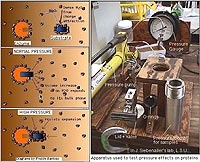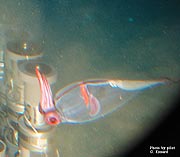Pressure
| High hydrostatic pressure (from the weight of the water column overhead) squeezes anything with an air chamber, such as fishes with swimbladders. Many deep-sea fishes do have fat-filled or vestigial swimbladders to avoid this problem, but some do have air-filled ones. These require considerable energy to inflate, and they expand (often lethally) when the fish is hauled to the surface. Pressure does not cause large-scale compression of most deepsea life due to the absence of air chambers, but it affects all life at a microsopic scale. It forces water molecules to stay densely bound to charged molecules, which interferes with critical binding events in cells (such as an energy-yielding molecule binding to an enzyme). For pressure adaptations, see below. |
 |
The highest pressures are found in the Challenger Deep of the Mariana Trench and the Mindanao Trench in the western Pacific. They are almost 36,000 ft or 11,000 m deep with almost 1100 atm of pressure. The Mariana Trench has explored by submersible only 3 times: 1) briefly by the manned sub Trieste in 1960; 2) by a Japanese unmanned submersible, "Kaiko", which was unfortunately lost at sea in Sept. 2003; and 3) by a new US unmanned hybrid sub Nereus in 2009. For depth limits of submersibles and life, see the Smithsonian's How Deep Can They Go page, and Extreme Science's Deep Ocean Creatures page.
Sulfide
Deep-sea animals at hydrothermal vents and gas seeps face another stress: high levels of hydrogen sulfide (H2S), a gas normally toxic to animals. However, giant tubeworms and certain clams and mussels at vents and seeps rely on sulfide-metabolizing bacterial symbionts in their internal tissues. Somehow the animals avoid sulfide toxicity - by binding sulfide to special proteins or converting it into non-toxic molecules. For our work on sulfide adaptations, see section 2 below. For pictures, see Seeps and Vents page.
 |
 |
 |
 |
1. Trawl and Alvin dive sites off Oregon
Click here for schematic diagram. [3-D images of the seafloor can be see in Scientific American June 1997 (Oregon coast on p.84)] |
2. Styrofoam head before and after a trip on the ALVIN
Hydrostatic pressure increases by 1 atm with each 10m of depth. This shows effects of 50 to 90 atm pressure on a styrofoam head taken to 520m and 906m on the Alvin (images at same scale) |
3. Swimbladder decompression
A rattail hauled for 2 hrs to surface from 2000m. The air-filled bladder cannot be adjusted fast enough for low pressure, and it expands out the mouth. Eyes are also pushed out by expanding air. |
4. A transparent squid visits Alvin.
Squids and most animals in the oceans do not have air chambers in them, so they do not suffer from large-scale pressure effects. However, they do have to cope with microscopic effects on proteins and membranes; see OUR PRESSURE RESEARCH below. |
Next: Our Deep-Sea Research .... |
|